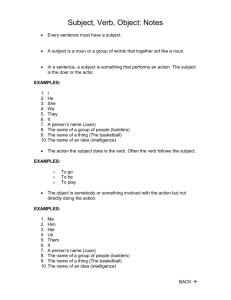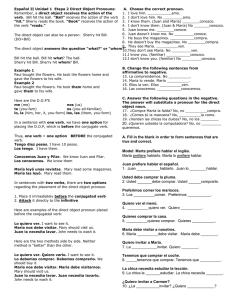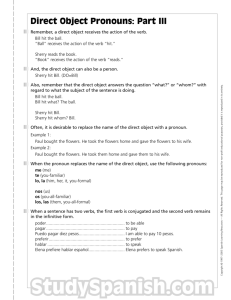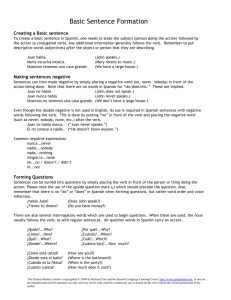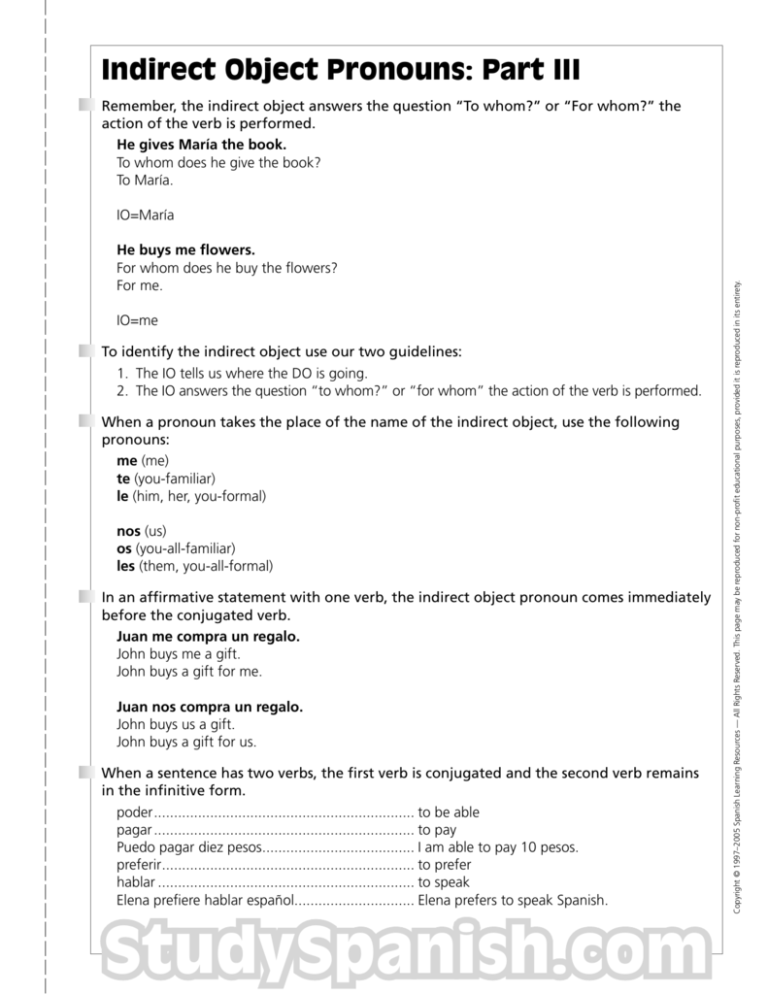
Indirect Object Pronouns: Part III
Remember, the indirect object answers the question “To whom?” or “For whom?” the
action of the verb is performed.
He gives María the book.
To whom does he give the book?
To María.
He buys me flowers.
For whom does he buy the flowers?
For me.
IO=me
To identify the indirect object use our two guidelines:
1. The IO tells us where the DO is going.
2. The IO answers the question “to whom?” or “for whom” the action of the verb is performed.
When a pronoun takes the place of the name of the indirect object, use the following
pronouns:
me (me)
te (you-familiar)
le (him, her, you-formal)
nos (us)
os (you-all-familiar)
les (them, you-all-formal)
In an affirmative statement with one verb, the indirect object pronoun comes immediately
before the conjugated verb.
Juan me compra un regalo.
John buys me a gift.
John buys a gift for me.
Juan nos compra un regalo.
John buys us a gift.
John buys a gift for us.
When a sentence has two verbs, the first verb is conjugated and the second verb remains
in the infinitive form.
poder ................................................................. to be able
pagar ................................................................. to pay
Puedo pagar diez pesos...................................... I am able to pay 10 pesos.
preferir ............................................................... to prefer
hablar ................................................................ to speak
Elena prefiere hablar español.............................. Elena prefers to speak Spanish.
StudySpanish.com
Copyright © 1997–2005 Spanish Learning Resources — All Rights Reserved. This page may be reproduced for non-profit educational purposes, provided it is reproduced in its entirety.
IO=María
In sentences with two verbs, there are two options regarding the placement of the
indirect object pronoun.
1. Place it immediately before the conjugated verb
2. Attach it directly to the infinitive
Here are examples of the indirect object pronoun attached directly to the infinitive:
Necesitas darme un regalo ................................. You need to give me a gift.
Necesito comprarte un sombrero........................ I need to buy you a hat.
Juan debe prestarnos el dinero ........................... Juan must lend us the money.
María quiere alquilarle a Juan el apartamento .... María wants to rent the apartment to Juan.
Here are the two methods side by side. Neither method is “better” than the other.
Me necesitas dar un regalo.
Necesitas darme un regalo.
You need to give me a gift.
Te necesito comprar un sombrero.
Necesito comprarte un sombrero.
I need to buy you a hat.
Juan nos debe prestar el dinero.
Juan debe prestarnos el dinero.
Juan must lend us the money.
María le quiere alquilar a Juan el apartamento.
María quiere alquilarle a Juan el apartamento.
María wants to rent the apartment to Juan.
When reading or hearing sentences like these, you must learn to recognize whole groups
of words, rather than inspecting each word independently.
Me necesitas dar un regalo.
Me necesitas dar = You need to give me
Necesitas darme un regalo.
Necesitas darme = You need to give me
Te necesito comprar un sombrero.
Te necesito comprar = I need to buy you
Necesito comprarte un sombrero.
Necesito comprarte = I need to buy you
StudySpanish.com
Copyright © 1997–2005 Spanish Learning Resources — All Rights Reserved. This page may be reproduced for non-profit educational purposes, provided it is reproduced in its entirety.
Here are examples of the indirect object pronoun placed before the conjugated verb:
Me necesitas dar un regalo ................................ You need to give me a gift.
Te necesito comprar un sombrero ....................... I need to buy you a hat.
Juan nos debe prestar el dinero .......................... Juan must lend us the money.
María le quiere alquilar a Juan el apartamento ... María wants to rent the apartment to Juan.
Your success in being able to recognize these groups is largely dependent upon having
learned previous material—namely verb conjugation.
You need to be able to quickly recognize a conjugated verb and an infinitive. You need to
automatically recognize “necesito comprar” as “I need to buy.”
StudySpanish.com
Copyright © 1997–2005 Spanish Learning Resources — All Rights Reserved. This page may be reproduced for non-profit educational purposes, provided it is reproduced in its entirety.
If you can do that, it is just one small step to recognize “te necesito comprar” as “I need to buy for
you.” From there, the final step is easy: “Te necesito comprar un regalo.”

